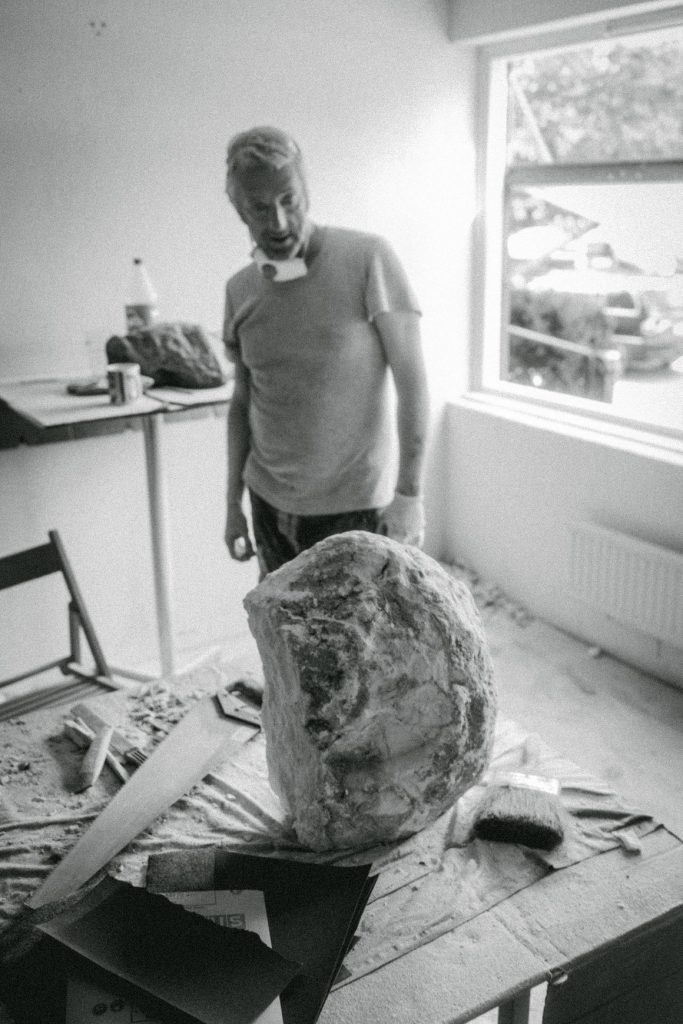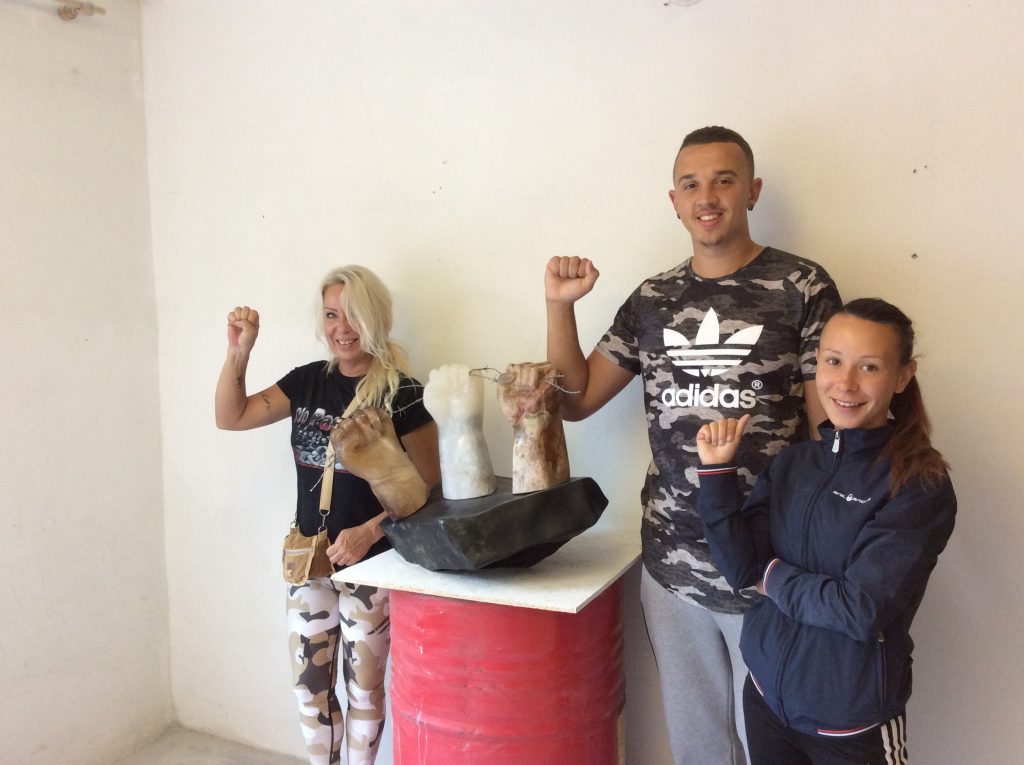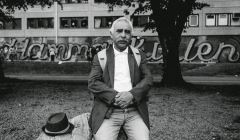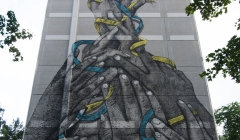Rob MacDonald is a British born artist who lives and works in Barcelona. He often works in stone, but also with music, poetry, and performance. MacDonald is also a founding member and editor of the Bad Art World Network, a platform for radical artists aiming to unite the struggles of artist with workers and community organizations for socialist change. Rob Macdonald was one of the international artists invited to the festival Hammarkullen Urban Arts 2017 (HUA17).
Hammarkullen is a well-known working class suburb in Sweden, which perhaps is better described as a “project” in the American sense of the word. In Sweden the term förort, which literally means “suburb”, is mostly used to describe a specific type of suburb. Areas that in the media are not often associated with art as much as they are with crime and difficult social circumstances. When Rob MacDonald arrived he found something both familiar and strange at the same time.
— I found it really interesting. My impression of the place was a big contrast to the type of British working-class estate which I am very used to. Hammarkullen had stone everywhere and areas reminiscent of countryside which British working-class houses would not be surrounded by, says Rob MacDonald.

The mixture of forrest and high-rises, which is something quintessential to the Swedish förort, MacDonald found very different and inspiring. That as well as the symbiosis of the very diverse population.
— I went to the Gothenburg city-center just one time, to understand the contrast. The rest of the time I spent in Hammarkullen. So I was very much encapsulated in the area, and was struck by the multicultural communities in the area. A diverse mix of people from all around the world that had migrated to Sweden during historically different times. And then layers of modern immigration. It was like the whole world popped up on the outskirts of the city and was forgotten. Almost like they ran their own affairs – like a mini republic. The community’s will to organize really struck me. To see it functioning in this multicultural way where they all seemed to be together, even with all the social problems.
It was like the whole world popped up on the outskirts of the city and was forgotten.
Rob MacDonald’s current main project is a major Spanish Civil War memorial in Malgrat de Mar, about an hour’s drive north along the coast from Barcelona in Catalonia. That same theme of struggle can easily be connected to Hammarkullen, a place where many have fled armed conflict in regions across the globe. But Rob MacDonald would also find a second interconnected theme. He would do this while learning about the people of Hammarkullen, seeing how the area can organize.
– I made two artworks in stone. Lost at Sea and Hammarkullen Rising. With Lost at Sea I drew on two connected themes. One which I brought with me, the other I found on arrival. The first theme was the project that I am currently doing in Catalonia. It’s about the people aboard the ship Ciudad de Barcelona who were killed by fascists in the Mediterranean, in 1937, during the Spanish Civil War. One of the survivors actually came from Sweden.

— The second theme was about the deaths of the many immigrants that today escape war and oppression in their own countries, but whose lives are lost in the Mediterranean sea – which I consider disgraceful. Many of these communities are represented in Hammarkullen. So the sculpture is three fists of different colors representing the different types of peoples. Not necessarily on the basis of ethnicity. The theme is that we are all different but we are all the same. That is something that should be celebrated, and something I felt from being in Hammarkullen.
The three fists are made of alabaster and the boat is made of soapstone. Rob MacDonald’s second piece, Hammarkullen Rising, is a clenched fist emerging from a stone.
— That piece was about the whole community of Hammarkullen together in unity, breaking through the stone with one fist. The reason is that I found this very united community, with all these layers of potential problems. But they seemed to be fighting together. Coming out of the stone that also surrounds this neighborhood. Both sculptures have fists in them because they were about struggle.

I think the two local artists were the most intriguing of all the artists because they both said they were not artists and for me that rings that they are just ordinary people. That is how I see myself as well.
While working in Hammarkullen Rob MacDonald set up a tent in different places of the community. Sometimes serving as a storage room when it rained, sometimes as makeshift workshop. For a lot of the time he set up next to where local artists Nabila Abdul Fattah and Iman Hussein were working. And there was common ground beyond just sharing a spot.
— Nabila also painted a fist on her building. We were doing fists independently from each other, which I found very interesting. I think the two local artists were the most intriguing of all the artists. They both said they were not artists, and for me that rings that they are just ordinary people. That is how I see myself as well.
Continuing the community driven process he has been practicing in Magret del Mar with the monument to the victims of the Ciudad de Barcelona, Rob MacDonald directly involved the community in the crafting of both his pieces. Hammarkullen Rising, the clenched fist coming out of a rock, and Lost at Sea, the fists clasping barbed wire.
— My workshop and tent were open, anyone could just come and help me. That’s the way I like to work with community involvement. I think it caused a lot of interest – someone sculpting in the street was a challenge to the norm. I always try to break down the barrier of sculpting because people think it’s super difficult. It’s not, it’s actually very relaxing. “Have a go,” I say, “help me.” If the weather had been a bit better there would have been even more possibilities of moving around, but there was great response to it.
— People were also really interested when I explained what I was making and why. I think this was what was wanted above all in the festival. I do incorporate the fact that the local people should make this art. It should belong to them, not be presented to them. Click To Tweet That is not always the easiest thing to do.

When I went to Gothenburg city for one day I went to the art museum. I do not have anything against the art museum, apart from that is has nothing to do with where I was staying.
For Rob MacDonald the communal process was something he had already worked with, but it was also part of the intention of the festival, which featured eight artists in total. The premise was for the artists to get to know the community and have some form of dialogue, in which ever way they preferred. Most artists had already been to Hammarkullen on a prior occasion, which would now allow for a longer relationship to influence the art.
— The first week I was invited to speak in a meeting so that I got to know more about the community. I spoke with around 40 women, mainly Somalian, about art and revolution. For me it was very different and very inspiring to be in the area like this, having such a positive experience. During the process of the making, the second week, as an example, I met some young Kurds and some Somalians – local people, and had a lot of really positive discussions. It wasn’t just a piece of art. It formed whole conversations about all sorts of topics.
The conversations often tied into contemporaneous issues of concern for the people in the area. For Rob MacDonald this is something that is the essence of community art: the engagement. An engagement he failed to find in the city museum in the inner city of Gothenburg.
— I had a long discussion with a Kurdish guy because I spoke about the International Brigadistas a lot, and that I partly based my artwork on that. It touched a nerve with what is going on in Kurdistan at the moment. Our conversation focused on questions of how we organize to change things all across the world and what we have to do to make a change. For me when art engages people in political discussions that is when you are doing community art. In contrast, when I went to Gothenburg city for one day I went to the art museum. I don’t have anything against the art museum, apart from that is has nothing to do with where I was staying.
Good community art should always be stepping over the line, questioning. It has to if it is going to be real.
That Gothenburg in previous governments de facto had a longstanding non-tolerance policy toward grafitti and that Hammarkullen Urban Art 2017 had support from the local community is something that Rob Macdonald thinks creates an interesting situation, one that immediately places the whole project “on the line”. Which is something one should strive towards when practicing community art, according to MacDonald.
— The size of the murals during the festival were enormous. When talking to Daniel Terres, the organizer of Urban Art [the main group behind the festival], I realized how challenging the project really was to see through. Because of the politics of non-tolerance toward graffiti that Gothenburg had in previous governments, to have these ginormous walls was basically saying “fuck off”. I thought that was phenomenal. I think that this in itself put the project in a really interesting place from day one. The fact that it was a people-led project, from a community like this, supported by the tenant associations, again makes it a fascinating situation. There could be rising complications with authorities, and it strikes me that this was a project that was on the line. Good community art should always be stepping over the line, questioning. It has to if it’s going to be real.
You’ve spoken about your community-based work and one of the focuses of the festival was a community-based process. Tell us a little bit more about how that relates to you as an artist, Rob.
— I want the finished piece to speak for itself but really the process also needs to speak for itself. The pieces I did in Hammarkullen were all about the process. Being there and the things I experienced and with my ability to manipulate stone I was trying to tell a story. The purpose wasn’t to make it surreal. It was about reflecting our society into each other in a clear way. The limit is only your imagination, and so when you allow the art room you allow everything.
For us it is not that we are political artists, it is that we are artists that are political.
— This is one of the reasons why I am part of the Bad Art World Network, which is about artists fighting for the freedom of art. For us it is not that we are political artists, it is that we are artists that are political. In the past you would have futurism, modernism, surrealism, and many other interesting art movements that were political. I like to embrace many of the things they stood for, but today an interdisciplinary approach is common. Use of waste materials is also common. What forms you use are less important, but what you stand for, to me, is more important now.
How so?
— Art in our society is separated from ordinary people. It is often supposed that art of any worth is only something for people with money. That only clever people or people with a particular skill can do it. This is not true in my opinion, and we have to fight this view. Art is a right not a privilege. Click To Tweet
Can you give us an example?
— Take myself, I am a stone worker that has a passion for creativity that’s all. I’m not special, I am just being human. For me that link is super important. The project in Hammarkullen is very good for me, as on another level it was trying to do something about community access and the freedom for art. To say something else. To put the debate about what art is for, at the center of society. What is it for? Who for? And why!? The journey of an artist never stops. It is a journey of discovery, but not in a blind way. In a way that liberates humanity. And that is my view on art.





1 kommentar
Pingback: I huvudet på Kristofer Lundberg: politisk kamp & konst - Kultwatch